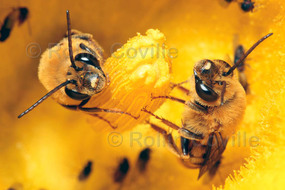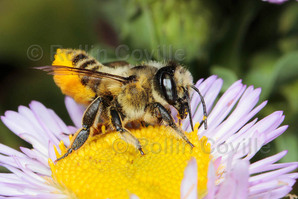Specialists vs. Generalists
Most bees can be separated into two categories of female pollen preferences, either specialists or generalists. Specialist bees have evolved a specific relationship with a few or even just one plant species. Some specialist bees forage for pollen that can only be found on one plant species. These specialist bees emerge from their nests at the same time their host plant begins to flower. The host flower sometimes depends on pollination from one specific bee species and the bee depends on pollen from their specific flower species. This mutualistic relationship can be found all over the world. On the other side of the spectrum, generalist bees are not too picky about the flowers they visit, and often visit a wide range of flower types and species when seeking out pollen.
Specialist Bees

Male squash bees waiting for a
female inside a squash flower.
In the SF Bay Area, you can see both specialist and generalist bees visiting flowers. Two types of plants that attract specialist bees are squashes, like pumpkins, squash and zucchini (Cucurbita spp.) and sunflowers (Helianthus spp.).
The squash bee (Peponapis pruinosa) is found all across North America and follows the blossoms of squash plants (family Cucurbitaceae). Squash bees are most active very early in the morning when the blossoms are open. While the squash bee is the main pollinator of this plant, we occasionally see other generalists like honey bees visiting the flowers.
The squash bee (Peponapis pruinosa) is found all across North America and follows the blossoms of squash plants (family Cucurbitaceae). Squash bees are most active very early in the morning when the blossoms are open. While the squash bee is the main pollinator of this plant, we occasionally see other generalists like honey bees visiting the flowers.
 Diadasia ochracea on Malacothamnus.
Diadasia ochracea on Malacothamnus.
The bee specialist on sunflowers (Helianthus spp.) is the sunflower bee (Diadasia enavata), though many other bee species can be found foraging on sunflowers. In Berkeley, we have found that even a small patch of sunflowers has been able to draw the sunflower bee. Other species of Diadasia also specialize on different flowers including: cactus, mallows, morning-glory, or Clarkia spp.
Generalist Bees

A female Megachile perihirta on seaside daisy.
Generalist bees are by far the most abundant bees in most urban gardens. During the summer, the two most common bees we have seen are long-horned bees (Melissodes robustior) and leaf cutter bees (Megachile perihirta). These bees can be found foraging on a number of flowers including Mexican aster (Cosmos bipinnatus), blanketflower (Gaillardia grandiflora), sunflower (Helianthus spp.), seaside daisy (Erigeron glaucus), bush sunflower (Encelia californica), and golden goddess (Bidens ferulifolia). Their pollen needs are not restricted to one specific flower host, which allows them to forage more freely and for a longer period of time. These bees have a longer “season” than some other bees because they are able to forage on such a wide variety of flowers.
